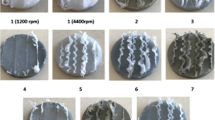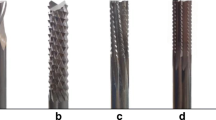Abstract
Polymer matrix composites (PMCs) have become one of the most widely used engineering materials due to both the developments in polymers and advanced fillers. It is expected that polymer composites will take their final shape during the production phase, which means that they are not required to undergo new processes. However, in some applications, machining operations, such as turning, milling, grooving and hole drilling, cannot be avoided and thus, finishing operations must be applied to these materials. Since these materials have complex microstructures, finishing operations may cause situations that adversely affect engineering properties, such as matrix cracking, delamination, debonding, etc. In this study, micro-milling operations were performed for recently developed ceramic reinforced polymer composites. Three different spindle speeds were used while feed rate and cutting depth were kept constant in the operations. The composites were produced from powdered UHMWPE and silicon carbide particles. Several parameters were varied in the production of the composites, such as molding pressure, filler loading and filler size. The investigated outputs were cutting temperature and surface roughness, whereas machined surfaces and chip morphologies were also investigated via microscopy analyses. In the final stage, regression analyses were performed to investigate the relationships between the process parameters. According to the results, ceramic reinforced polymer composites exhibit different machinability properties than fiber-reinforced ones due to hard fillers and low melting point of UHMWPE.











Similar content being viewed by others
Abbreviations
- ANOVA:
-
Analysis of variance
- CFRP:
-
Carbon fiber-reinforced polymer
- EDS:
-
Energy-dispersive spectrometry
- PMC:
-
Polymer matrix composite
- SEM:
-
Scanning electron microscopy
- SiC:
-
Silicon carbide
- UHMWPE:
-
Ultra-high molecular weight polyethylene
References
Jiang Z, Zhao J, Xie H. Microforming technology: theory, simulation and practice. London: Academic Press; 2017.
Koç M (2020) Micro-manufacturing: design and manufacturing of micro-products. Hoboken: Wiley; 2011. https://www.myilibrary.com/?id=305245. Accessed 19 Mar 2020 (Online).
Razali AR, Qin Y. A review on micro-manufacturing, micro-forming and their key ıssues. Procedia Eng. 2013;53:665–72. https://doi.org/10.1016/j.proeng.2013.02.086.
Ratchev S, International Federation for Information Processing, (editors). Precision assembly technologies and systems: 5th IFIP Wg 5.5 International precision assembly seminar, proceedings. Chamonix, Berlin: IPAS 2010, Springer; 2010.
Qin Y, et al. Development of a new machine system for the forming of micro-sheet-products. Int J Mater Form. 2008;1(S1):475–8. https://doi.org/10.1007/s12289-008-0098-9.
Sharma AK, Bhandari R, Aherwar A, Rimašauskienė R. Matrix materials used in composites: a comprehensive study. Mater Today Proc. 2020;21:1559–62. https://doi.org/10.1016/j.matpr.2019.11.086.
Kumar R, Singh S, Sidhu AS, Pruncu CI. Bibliometric analysis of specific energy consumption (SEC) in machining operations: a sustainable response. Sustainability. 2021;13(10):5617. https://doi.org/10.3390/su13105617.
Ahmad J. Machining of polymer composites. Boston: Springer; 2009. https://doi.org/10.1007/978-0-387-68619-6.
Hocheng H, editor. Machining technology for composite materials: principles and practice. Cambridge, Philadelphia: Woodhead Publishing; 2012.
Sheikh-Ahmad J, Twomey J, Kalla D, Lodhia P. Multiple regression and committee neural network force prediction models in milling FRP. Mach Sci Technol. 2007;11(3):391–412. https://doi.org/10.1080/10910340701554873.
Gara S, Tsoumarev O. Effect of tool geometry on surface roughness in slotting of CFRP. Int J Adv Manuf Technol. 2016;86(1–4):451–61. https://doi.org/10.1007/s00170-015-8185-9.
Gara S, M’hamed S, Tsoumarev O. Temperature measurement and machining damage in slotting of multidirectional CFRP laminate. Mach Sci Technol. 2018;22(2):320–37. https://doi.org/10.1080/10910344.2017.1365892.
Azmi AI, Lin RJT, Bhattacharyya D. Machinability study of glass fibre-reinforced polymer composites during end milling. Int J Adv Manuf Technol. 2013;64(1–4):247–61. https://doi.org/10.1007/s00170-012-4006-6.
Ghafarizadeh S, Chatelain J-F, Lebrun G. Finite element analysis of surface milling of carbon fiber-reinforced composites. Int J Adv Manuf Technol. 2016;87(1–4):399–409. https://doi.org/10.1007/s00170-016-8482-y.
He Y, Qing H, Zhang S, Wang D, Zhu S. The cutting force and defect analysis in milling of carbon fiber-reinforced polymer (CFRP) composite. Int J Adv Manuf Technol. 2017;93(5–8):1829–42. https://doi.org/10.1007/s00170-017-0613-6.
Pecat O, Rentsch R, Brinksmeier E. Influence of milling process parameters on the surface ıntegrity of CFRP. Procedia CIRP. 2012;1:466–70. https://doi.org/10.1016/j.procir.2012.04.083.
Iskandar Y, Tendolkar A, Attia MH, Hendrick P, Damir A, Diakodimitris C. Flow visualization and characterization for optimized MQL machining of composites. CIRP Ann. 2014;63(1):77–80. https://doi.org/10.1016/j.cirp.2014.03.078.
Hintze W, Hartmann D. Modeling of delamination during milling of unidirectional CFRP. Procedia CIRP. 2013;8:444–9. https://doi.org/10.1016/j.procir.2013.06.131.
Szallies K, Siebert N, Bergmann JP. Low frequency oscillated milling of carbon fiber-reinforced plastics. Procedia CIRP. 2017;66:153–8. https://doi.org/10.1016/j.procir.2017.03.298.
Mishra TK, Kumar A, Verma V, Pandey KN, Kumar V. PEEK composites reinforced with zirconia nanofiller. Compos Sci Technol. 2012;72(13):1627–31. https://doi.org/10.1016/j.compscitech.2012.06.019.
Agrawal A, Satapathy A. Thermal and dielectric behaviour of polypropylene composites reinforced with ceramic fillers. J Mater Sci Mater Electron. 2015;26(1):103–12. https://doi.org/10.1007/s10854-014-2370-8.
Ge S, et al. Friction and wear behavior of nitrogen ion implanted UHMWPE against ZrO2 ceramic. Wear. 2003;255(7–12):1069–75. https://doi.org/10.1016/S0043-1648(03)00269-2.
Xiong D, Ge S. Friction and wear properties of UHMWPE/Al2O3 ceramic under different lubricating conditions. Wear. 2001;250(1–12):242–5. https://doi.org/10.1016/S0043-1648(01)00647-0.
Gao P, Mackley MR. The structure and rheology of molten ultra-high-molecular-mass polyethylene. Polymer. 1994;35(24):5210–6. https://doi.org/10.1016/0032-3861(94)90471-5.
Kuram E. Micro-machinability of injection molded polyamide 6 polymer and glass-fiber reinforced polyamide 6 composite. Compos Part B Eng. 2016;88:85–100. https://doi.org/10.1016/j.compositesb.2015.11.004.
Campos Rubio JC, Panzera TH, Scarpa F. Machining behaviour of three high-performance engineering plastics. Proc Inst Mech Eng Part B J Eng Manuf. 2015;229(1):28–37. https://doi.org/10.1177/0954405414525142.
Wu JJ, Buckley CP, O’Connor JJ. Mechanical integrity of compression-moulded ultra-high molecular weight polyethylene: effects of varying process conditions. Biomaterials. 2002;23(17):3773–83. https://doi.org/10.1016/S0142-9612(02)00117-5.
Parasnis NC, Ramani K. Analysis of the effect of pressure on compression moulding of UHMWPE. J Mater Sci Mater Med. 1998;9(3):165–72. https://doi.org/10.1023/A:1008871720389.
Gürgen S. Wear performance of UHMWPE based composites including nano-sized fumed silica. Compos Part B Eng. 2019;173: 106967. https://doi.org/10.1016/j.compositesb.2019.106967.
Gürgen S, Çelik ON, Kuşhan MC. Tribological behavior of UHMWPE matrix composites reinforced with PTFE particles and aramid fibers. Compos Part B Eng. 2019;173: 106949. https://doi.org/10.1016/j.compositesb.2019.106949.
Carr JW, Feger C. Ultraprecision machining of polymers. Precis Eng. 1993;15(4):221–37. https://doi.org/10.1016/0141-6359(93)90105-J.
Wang S, Ge S. The mechanical property and tribological behavior of UHMWPE: effect of molding pressure. Wear. 2007;263(7–12):949–56. https://doi.org/10.1016/j.wear.2006.12.070.
Sivasakthivel PS, Sudhakaran R. Optimization of machining parameters on temperature rise in end milling of Al 6063 using response surface methodology and genetic algorithm. Int J Adv Manuf Technol. 2013;67(9–12):2313–23. https://doi.org/10.1007/s00170-012-4652-8.
Gürgen S, Sofuoğlu MA. Advancements in conventional machining. In: Advanced machining and finishing. Amsterdam: Elsevier; 2021. pp. 143–175. https://doi.org/10.1016/B978-0-12-817452-4.00015-4.
Çakır FH, Sofuoğlu MA, Gürgen S. Machining of Hastelloy-X based on finite element modelling. Adv Eng Forum. 2018;30:1–7. https://doi.org/10.4028/www.scientific.net/AEF.30.1.
Rashed AH. Properties and characteristics of silicon carbide. Poco Graphite Inc.; 2002. p. 1–19.
Acknowledgements
The authors gratefully acknowledge the financial support by the Research Fund of Eskişehir Osmangazi University, Project #202015046.
Funding
Research Fund of Eskişehir Osmangazi University, Project #202015046.
Author information
Authors and Affiliations
Contributions
Conceptualization: SG; methodology: SG; writing—reviewing and editing: SG; investigation: MAS, data curation: MAS; software: MAS.
Corresponding author
Ethics declarations
Conflict of interest
All authors declare that they have no conflict of interest.
Availability of data and material
The raw/processed data required to reproduce these findings cannot be shared at this time as the data also forms part of an ongoing study.
Code availability
Not applicable.
Additional information
Publisher's Note
Springer Nature remains neutral with regard to jurisdictional claims in published maps and institutional affiliations.
Appendix
Appendix
Full set of thermography images are given in Fig. 12.
Rights and permissions
About this article
Cite this article
Gürgen, S., Sofuoğlu, M.A. Micro-machining of UHMWPE composites reinforced with carbide fillers. Archiv.Civ.Mech.Eng 21, 146 (2021). https://doi.org/10.1007/s43452-021-00299-z
Received:
Revised:
Accepted:
Published:
DOI: https://doi.org/10.1007/s43452-021-00299-z





